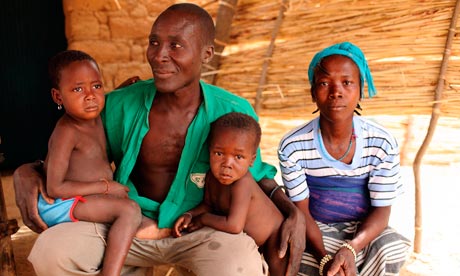Percentage of hungry people in developing countries falls to less than 15%, but progress on ending hunger is significantly slowing
A family near Diapaga, Burkina Faso. UN data shows global progress on reducing hunger is better than thought. Photograph: Raphael De Bengy/AFP/Getty Images
The international target to halve the prevalence of hunger in the world is within reach, the UN said on Tuesday, after publishing figures suggesting global progress on reducing hunger has been better than previously thought.
According to the new estimates of undernourishment, published in this year's State of food insecurity in the world report, the percentage of hungry people in developing countries has fallen from more than 23% in 1990-92 to less than 15% in 2010-12, bringing the estimated number of hungry people in developing regions to 850 million in 2010-12.
The figures point to an increase in the estimated number and proportion of hungry people in 1990, the baseline year for the millennium development goals (MDGs). They suggest there were nearly 1 billion undernourished people in the world in 1990, as opposed to the 833 million previously reported. This puts the MDG to halve the proportion of people who experience hunger within reach, says the report.
"The good news … is the hunger target of MDG one is achievable," said Jomo Kwame Sundaram, assistant director general for economic and social development at the Food and Agriculture Organisation (FAO). "There has been more progress than previously thought, and we're within striking distance."
Significantly, the figures do not show an increase in global hunger following the recent food price and economic crises. However, the report finds that from 2007 there has been "a significant slowdown" in progress, bringing hunger reduction "essentially to a halt for the developing countries as a whole". This will need to be reversed if the MDG is to be met, it says.
Tempering premature celebrations further, the report says the number of hungry people in the world "remains unacceptably high".
There are stark variations between regions. The figures put Asia and the Pacific, as well as Latin America and the Caribbean, almost on track for achieving their MDG hunger targets. Undernourishment in sub-Saharan Africa has improved less rapidly, and western Asia has seen an increase in the percentage of hungry people.
The report, launched by three UN food agencies ahead of the Committee on World Food Security meetings in Rome next week, calls for investment in smallholder farmers, "nutrition-sensitive" policies, and the creation of comprehensive social protection systems that target the poor.
The figures draw on updated data on food supplies, population, and the distribution of food as recorded by household surveys, and a methodology revised to capture estimated inequalities in food consumption. China's estimated population in the 1990s has been revised upwards by 25 million people, pushing up both the prevalence and absolute number of undernourished people at the time.
For the first time, the figures factor in estimates of food lost or wasted during distribution and storage. This revision causes the "most dramatic" change in the estimates, says the report. Estimates of food loss vary, but range from 2% for dry grains to 10% for fresh fruit and vegetables.
The UN hunger indicator, however, which focuses on chronic undernourishment measured by calorie intake, does not capture the effects of short-term price spikes and other economic shocks "unless these are reflected in changes in long-term food consumption patterns", says the report. It also wouldn't capture impacts beyond calorie intake, such as the deterioration in the quality of diet and reduced access to other basic needs such as healthcare or education.
The UN figures set the threshold for hunger as the minimum calories needed for a "sedentary lifestyle". The number of hungry people today could be as high as 1.5 billion (or more than 25% of the world's total), notes the report, if the threshold was set as the minimum needed for "normal activity", or nearly 2.6 billion (nearly 45%) for "intense activity".
To complement the indicator, the UN has released a suite of additional measures to give a more rounded picture of food insecurity and plans to run a global poll to monitor food insecurity based on peoples' experiences. This would "ensure timely monitoring of the difficulties that individuals and households face in accessing food, thus providing a direct basis for food security interventions", says the report.
The worst drought in half a century in the US has pushed up world prices of staples such as corn and wheat and placed food and agriculture high on the international agenda. Food prices are expected to feature on the agenda of this week's World Bank meetings in Tokyo. However, the G20 has called off an emergency meeting to discuss rising commodity prices, previously mooted for World Food Day, 16 October, in Rome.
Earlier this year, the World Bank said its data suggested the MDG to cut extreme poverty had been achieved by 2010. The UN announced in March that the MDG on safe drinking water had also been met in 2010, five years ahead of the 2015 deadline.












No comments:
Post a Comment